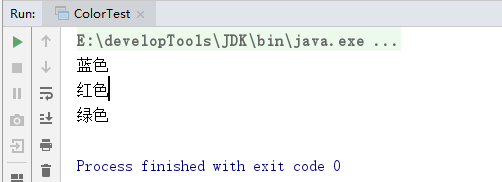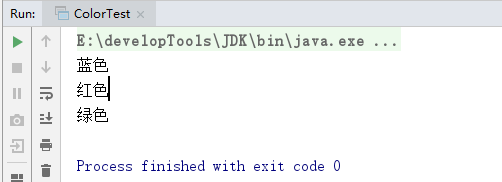设计模式之工厂模式
1.工厂模式的概念
实例化对象,用工厂方法代替new操作,工厂模式包括工厂方法模式和抽象工厂模式.抽象工厂模式的工厂方法模式的扩展
2.工厂模式的意图
定义一个接口来创建对象,但是让子类来决定那些类需要被实例化,工厂方法将实例化的工作推迟到子类中去实现.
3.工厂模式的应用场景
有一组类似的对象需要创建,在编码时不能预见需要创建哪种类的实例.系统需要考虑扩展性,不依赖于产品类实例如何被创建,组合和表达的细节.
4.工厂模式的设计思想
在软件系统中经常面临着对象的创建同工作,由于需求的变化,这个对象可能也随之发生变化,但它却拥有比较稳定的接口.为此,我们需要提供一种封装机制来隔离出这个异变对象的变化,从而保持系统中其他依赖该对象的对象不随着需求变化而变化.
5.工厂模式的好处
尽量松耦合,一个对象的依赖对象的变化与本身无关.
具体产品与客户端剥离,责任分割.


代码 简单工厂模式
1.先创建颜色接口 ColorInterface
/**
* 颜色接口
*/
public interface ColorInterface {
public void color();
}
2.不同的颜色类实现颜色接口
Blue
public class Blue implements ColorInterface {
public void color() {
System.out.println("蓝色");
}
}
Green
public class Green implements ColorInterface {
public void color() {
System.out.println("绿色");
}
}
Red
public class Red implements ColorInterface {
public void color() {
System.out.println("红色");
}
}
测试
public class ColorTest {
public static void main(String[] args) {
ColorInterface blue = new Blue();
blue.color();
ColorInterface red = new Red();
red.color();
ColorInterface green = new Green();
green.color();
}
}
结果

这样写很麻烦,现在需要一个颜色工厂来帮我们创建颜色的实例
创建颜色工厂
/**
* 颜色工厂
*/
public class ColorFactory {
public ColorInterface getColor(String type){
if ("blue".equals(type)){
return new Blue();
}else if ("red".equals(type)){
return new Red();
}else if ("green".equals(type)){
return new Green();
}
return null;
}
}
测试
public class ColorTest {
public static void main(String[] args) {
ColorFactory colorFactory = new ColorFactory();
colorFactory.getColor("blue").color();
colorFactory.getColor("red").color();
colorFactory.getColor("green").color();
}
}
结果

这样写工厂类就不灵活也不利于扩展,继续改进,利用反射来创建实例
颜色工厂类修改
/**
* 颜色工厂
*/
public class ColorFactory {
/**
* 根据类名称来生产对象
* @param className
* @return
*/
public ColorInterface getColor(String className){
try {
ColorInterface color = (ColorInterface) Class.forName(className).newInstance();
return color;
} catch (InstantiationException e) {
e.printStackTrace();
} catch (IllegalAccessException e) {
e.printStackTrace();
} catch (ClassNotFoundException e) {
e.printStackTrace();
}
return null;
}
}
测试
public class ColorTest {
public static void main(String[] args) {
ColorFactory colorFactory = new ColorFactory();
colorFactory.getColor("com.spring.factory.Blue").color();
colorFactory.getColor("com.spring.factory.Red").color();
colorFactory.getColor("com.spring.factory.Green").color();
}
}
结果

还可以将全限定名写入配置文件,通过配置文件中的key来实例化
在resource路径下新建type.pproperties配置文件
blue=com.spring.factory.Blue
red=com.spring.factory.Red
green=com.spring.factory.Green
新建PropertiesReader来读取配置文件
/**
* 读取properties文件
*/
public class PropertiesReder {
public Map<String,String> getProperties(){
Properties properties = new Properties();
Map<String,String> map = new HashMap<String, String>();
try {
InputStream in = getClass().getResourceAsStream("/type.properties");
properties.load(in);
Enumeration<?> enumeration = properties.propertyNames();
while (enumeration.hasMoreElements()){
String key = (String) enumeration.nextElement();
String property = properties.getProperty(key);
map.put(key,property);
}
} catch (IOException e) {
e.printStackTrace();
}
return map;
}
}
改写ColorFactory
/**
* 读取properties文件
*/
public class PropertiesReder {
public Map<String,String> getProperties(){
Properties properties = new Properties();
Map<String,String> map = new HashMap<String, String>();
try {
InputStream in = getClass().getResourceAsStream("/type.properties");
properties.load(in);
Enumeration<?> enumeration = properties.propertyNames();
while (enumeration.hasMoreElements()){
String key = (String) enumeration.nextElement();
String property = properties.getProperty(key);
map.put(key,property);
}
} catch (IOException e) {
e.printStackTrace();
}
return map;
}
}
测试
public class ColorTest {
public static void main(String[] args) {
ColorFactory colorFactory = new ColorFactory();
colorFactory.getColor("blue").color();
colorFactory.getColor("red").color();
colorFactory.getColor("green").color();
}
}
结果

抽象工厂模式
抽象工厂模式是围绕一个超级工厂创建其他工厂。该超级工厂又称为其他工厂的工厂。这种类型的设计模式属于创建型模式,它提供了一种创建对象的最佳方式。
在抽象工厂模式中,接口是负责创建一个相关对象的工厂,不需要显式指定它们的类。每个生成的工厂都能按照工厂模式提供对象。
代码
钢笔接口
/**
* 钢笔
*/
public interface Pen {
public void write();
}
橡皮接口
/**
* 橡皮
*/
public interface Eraser {
public void raclage();
}
红色钢笔
/**
* 红色钢笔
*/
public class RedPen implements Pen {
public void write() {
System.out.println("红色钢笔");
}
}
蓝色钢笔
/**
* 蓝色钢笔
*/
public class BluePen implements Pen {
public void write() {
System.out.println("蓝色钢笔");
}
}
红色橡皮
/**
* 红色橡皮
*/
public class RedEraser implements Eraser {
public void raclage() {
System.out.println("红色橡皮");
}
}
蓝色橡皮
/**
* 蓝色橡皮
*/
public class BlueEraser implements Eraser {
public void raclage() {
System.out.println("蓝色橡皮");
}
}
文具工厂
/**
* 文具工厂
*/
public interface StationeryFactory {
public Pen getPen();
public Eraser getEraser();
}
蓝色工厂
/**
* 蓝色工厂
*/
public class BlueFactory implements StationeryFactory {
public Pen getPen() {
return new BluePen();
}
public Eraser getEraser() {
return new BlueEraser();
}
}
红色工厂
/**
* 红色工厂
*/
public class RedFactory implements StationeryFactory {
public Pen getPen() {
return new RedPen();
}
public Eraser getEraser() {
return new RedEraser();
}
}
测试
public class Test {
public static void main(String[] args) {
StationeryFactory factory = new RedFactory();
factory.getEraser().raclage();
factory.getPen().write();
StationeryFactory factory1 = new BlueFactory();
factory1.getEraser().raclage();
factory1.getPen().write();
}
}
结果

抽象工厂模式
代码
形状接口
/**
* 形状接口
*/
public interface Shape {
void draw();
}
实现
public class Circle implements Shape {
public void draw() {
System.out.println("Circle : draw method");
}
}
public class Rectangle implements Shape {
public void draw() {
System.out.println("Rectangle : draw method");
}
}
public class Square implements Shape {
public void draw() {
System.out.println("Square : draw method");
}
}
颜色接口
/**
* 颜色接口
*/
public interface Color {
void fill();
}
实现
public class Red implements Color {
public void fill() {
System.out.println("Red : fill method");
}
}
public class Green implements Color {
public void fill() {
System.out.println("Green : fill method");
}
}
public class Blue implements Color {
public void fill() {
System.out.println("Blue : fill method");
}
}
抽象工厂
/**
* 抽象工厂
*/
public abstract class AbstractFactory {
abstract Color getColor(String color);
abstract Shape getShape(String shape);
}
形状工厂
/**
* 形状工厂
*/
public class ShapeFactory extends AbstractFactory{
Color getColor(String color) {
return null;
}
Shape getShape(String shape) {
if (shape == null){
return null;
}else if ("CIRCLE".equals(shape)){
return new Circle();
}else if ("SQUARE".equals(shape)){
return new Square();
}else if ("RECTANGLE".equals(shape)){
return new Rectangle();
}
return null;
}
}
颜色工厂
/**
* 颜色工厂
*/
public class ColorFactory extends AbstractFactory {
Color getColor(String color) {
if ("RED".equals(color)){
return new Red();
}else if ("BLUE".equals(color)){
return new Blue();
}else if ("GREEN".equals(color)){
return new Green();
}
return null;
}
Shape getShape(String shape) {
return null;
}
}
产品工厂
/**
* 产品工厂
*/
public class FactoryProducer {
public static AbstractFactory getFactory(String choice){
if(choice.equalsIgnoreCase("SHAPE")){
return new ShapeFactory();
} else if(choice.equalsIgnoreCase("COLOR")){
return new ColorFactory();
}
return null;
}
}
测试
public class Test {
public static void main(String[] args) {
AbstractFactory shape = FactoryProducer.getFactory("SHAPE");
AbstractFactory color = FactoryProducer.getFactory("COLOR");
shape.getShape("CIRCLE").draw();
shape.getShape("RECTANGLE").draw();
shape.getShape("SQUARE").draw();
color.getColor("RED").fill();
color.getColor("BLUE").fill();
color.getColor("GREEN").fill();
}
}
结果

记录学习过程,参考
http://www.runoob.com/design-pattern/abstract-factory-pattern.html






















 9357
9357











 被折叠的 条评论
为什么被折叠?
被折叠的 条评论
为什么被折叠?








